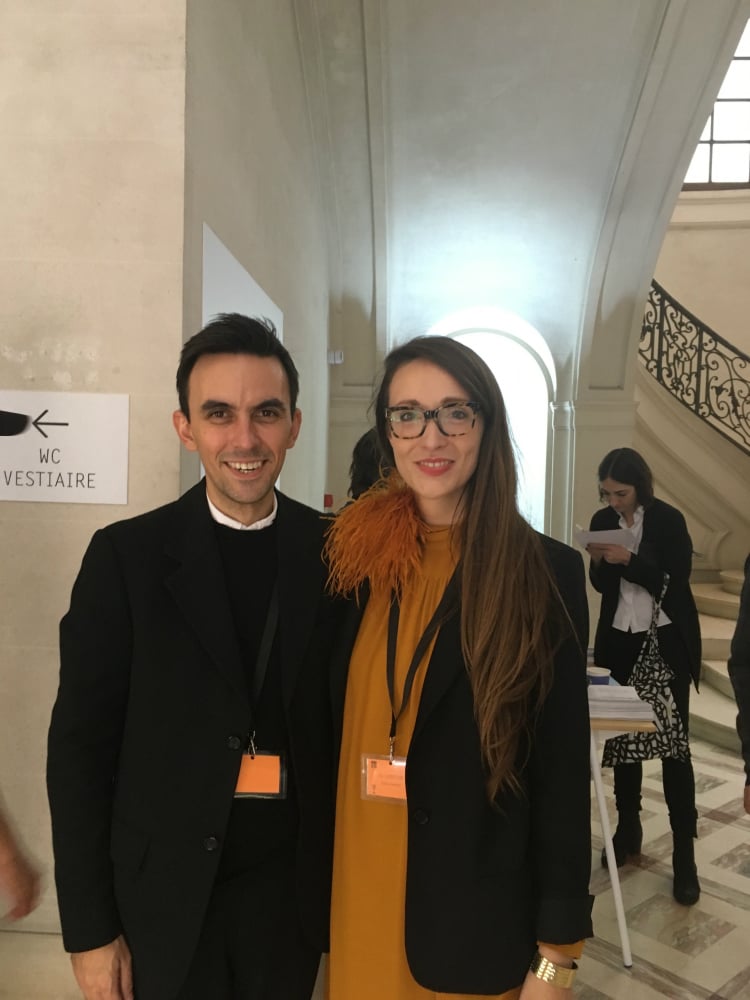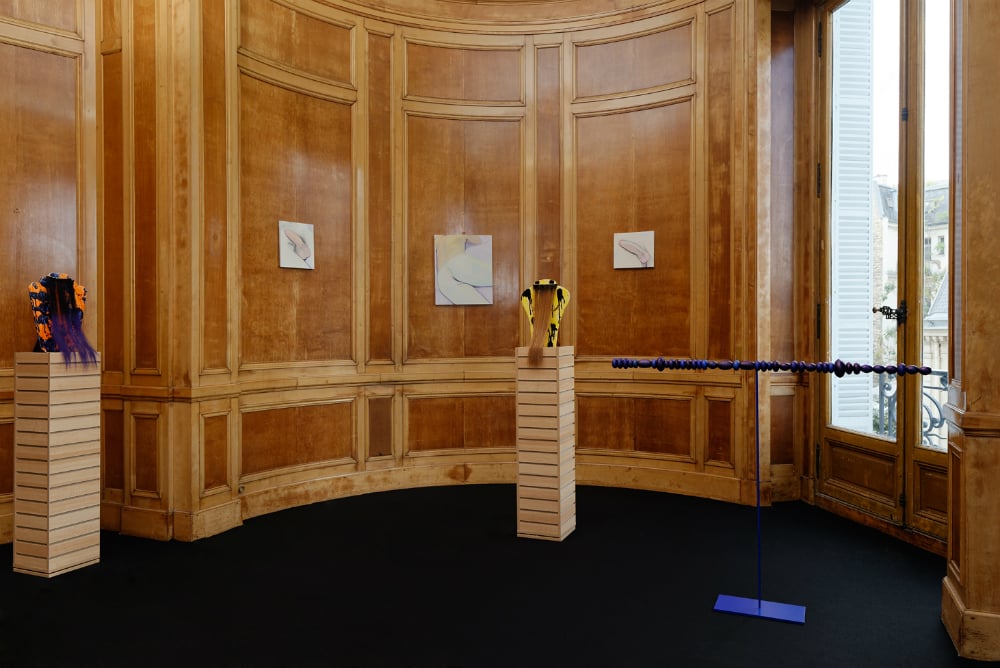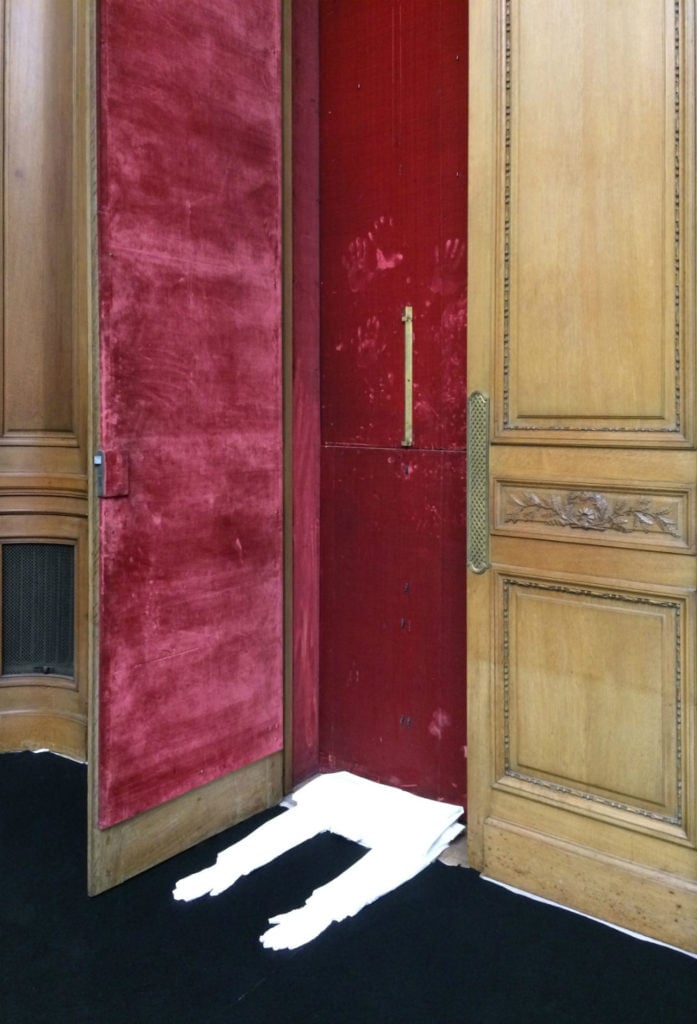Art Fairs
Young and Fun, Paris Internationale Fair Cements Its Reputation as a Serious Contender
Paris' hippest fair has doubled up in size in just one year.

Paris' hippest fair has doubled up in size in just one year.

Sarah Hyde

The second edition of the fair Paris Internationale, directed by the youthful duo Silvia Ammon and Clément Delépine, held its preview October 18, a day before FIAC. This fair may be young and fun, but it’s certainly not a game and it has doubled in size since its debut last year.
The fair takes place in the 19th century hôtel particulier home of Calouste Gulbenkian, situated just by the Arc De Triomphe, in the heartland of the most luxurious arrondissement. This is the house that featured in the Bertrand Bonello’s film Saint Laurent, and Paris Internationale takes place in it, including the servant’s quarters and the back stairs.
The entrance to the fair is very discreet. There is hardly any indication that there is an important art fair taking place inside, but this low key entrance works well, as does the apparent informality of the event. The atmosphere is enthusiastic, smart, friendly, and charming rather than dry and professional. All of this contributes to reducing expectations, which is perhaps intentional and means visitors will be all the more dazzled by the quality of the fair contained within.

Installation view of Kamrooz Aram, Nazgol Ansarinia, Chaouki Choukini, and Hera Buyuktasciyan at the booth of Green Art Gallery. Photo courtesy Green Art Gallery.
I was lucky enough catch up with Delépine, co-director of the fair at the entrance. “Participation at the fair is by invitation only. Gallerists submit their proposals and we allocate them spaces,” he said, explaining how Paris Internationale works and what makes it special.
Delépine’s extensive experience as a curator at the Swiss Institute in New York is evident and he delights in working with the space of the hôtel particulier. “It is so much more interesting than a sterile white space,” he said.
“We try and keep the cost of the booths down because we want people to take risks, I want the gallerists to feel that they can be braver,” he said, when asked about the cost to exhibitors.
The actual fee is between €4,000 and €8,000, depending on the size and location. Delépine has also included seven non-profit organisations into the mix, allowing them to sell at the fair at no extra cost, keeping the mixture vital and pure. To confuse this fair with anything outside or against the Parisian art establishment would be a mistake, however, as the large contingent of serious Swiss collectors leaving as I arrived demonstrated.
Delépine would like to see Paris Internationale as absolutely complementary to FIAC, although there is no official relationship between the two at this stage and FIAC has its own junior section. His nose screwed up when I suggested that it was a “feeder fair.” With prices ranging from between $1,000 and $50,000, the artists represented here are important if not yet stellar, and many have represented their countries at the biennales and have shown at major museums.

Celia Hempton at the booth of Galerie Sultana. Photo courtesy Galerie Sultana.
One of the intended functions of the fair is to bring international galleries into Paris. Of 53 galleries and 7 project spaces hailing from 19 countries, only 11 are local. Five are the galleries that established the fair: Crèvecoeur, High Art, Antoine Levi, Guillaume Sultana, and Gregor Staiger.
When I discussed this melting pot effect with Elyse Derosia, from the Bodega Gallery in New York, she said: “This was one of the major attractions of the fair, a chance to see works from artists who are represented in other countries and perhaps find potential synergy.”
On the day of the opening the atmosphere was cracking with energy and optimism. The booths are relatively small and gallerists can only offer a taste of what they sell, but it is the thoughtful positioning of each gallery that makes Paris Internationale work so well. It is almost like eating a carefully prepared tasting menu, one delightful artistic exchange follows the next. By careful curation, each is more outstanding because of its comparison with its close neighbor, and I suspect that Delépine and Ammon have big careers as curators ahead of them.
Moving around the fair, Dubai’s Green Art Gallery makes brilliant use of the display cabinets in their space, to show the works of Nazgol Ansarinia, a female artist from Tehran, who has represented her country at the Venice Biennale. Her practice involves breaking down domestic items and putting them back together again to explore the inner workings of a social system. By placing the works in this context they gain another layer of complexity.

Sean Townley, Untitled (suit) (2015). Photo Antoine Levi.
Further along, Joseph Tang gallery maximizes the use of the space, displaying Daiga Grantina’s show stopping Three Graces from the ceiling, blowing my theory that gallerists here are showing works that are easy to see on a domestic scale, and making Delépine’s words about wanting gallerists to take risks echo in my mind. The pieces own the space. In the next room, the delicate conceptual works of Guy Mees, exhibited by Brussel’s non-profit Bureau des Realities, appear even more fragile and minimal because of this genius juxtaposition.
The phrase “expect the unexpected” is perhaps the best guideline for visitors, and works by Kaoru Arima, from Tokyo’s Misako Rosen gallery, were particularly strong in the basement kitchen. My journey into the underbelly of the house continued with more joyful surprises, including discovering Bailey Scieszka, a larger than life performance artist from Detroit, as she lit up the gloomy laundry room.
Other personal highlights included Basim Magdy’s work at Hunt Kastner and Sean Townley at Antoine Levi, the amusing paintings by Celia Hempton at Sultana, and, of course, the intrepid OUTPOST, coming all the way from Norwich, on the top floor.
The second edition of the fair Paris Internationale takes places at 51 Avenue d’Iéna, Paris, from October 19-23, 2016.